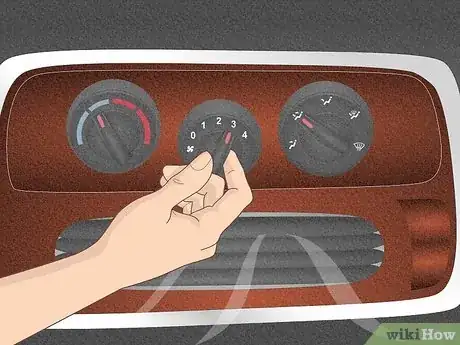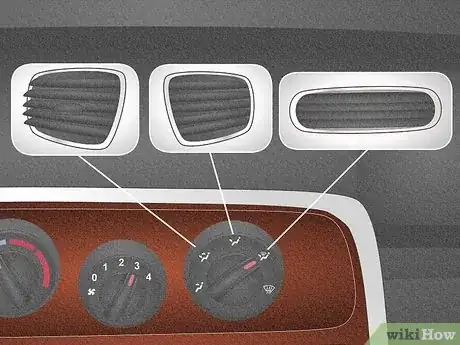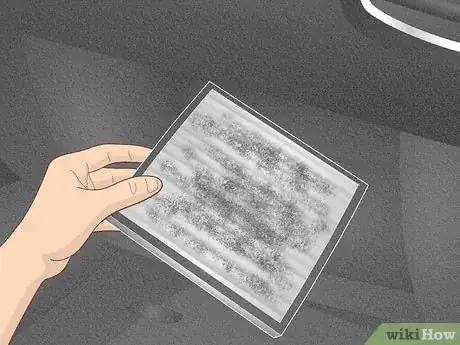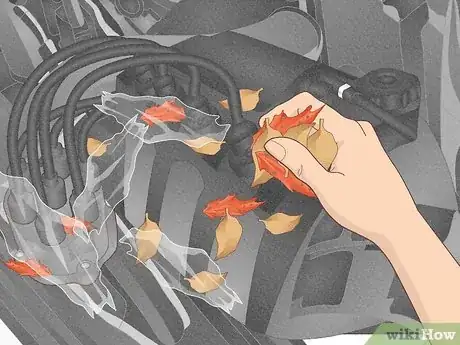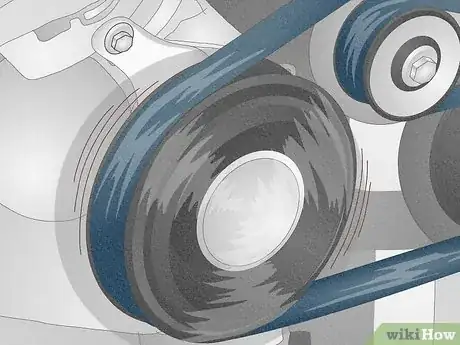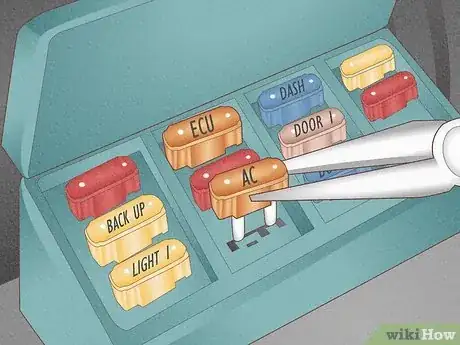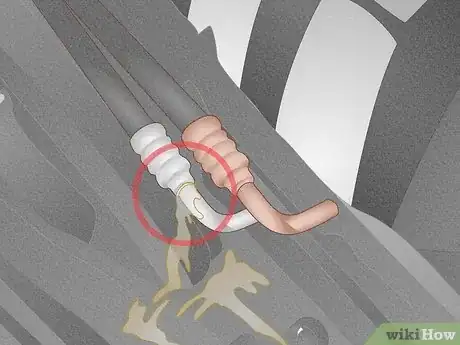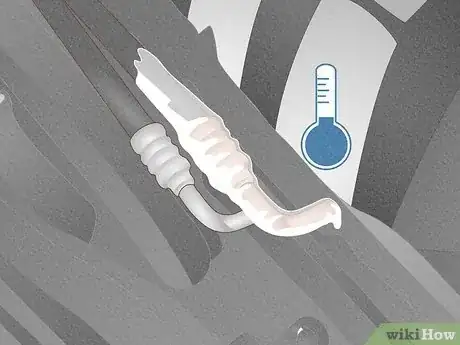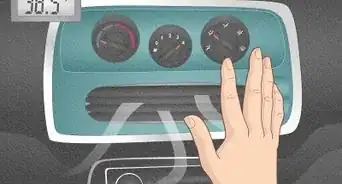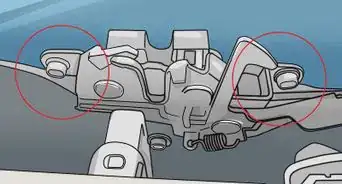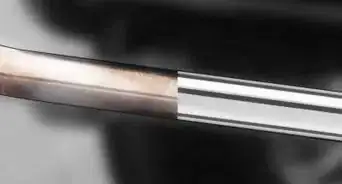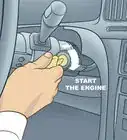This article was co-authored by Tom Eisenberg and by wikiHow staff writer, Eric McClure. Tom Eisenberg is the Owner and General Manager of West Coast Tires & Service in Los Angeles, California, a family-owned AAA-approved and certified auto shop. Tom has over 10 years of experience in the auto industry. Modern Tire Dealer Magazine voted his shop one of the Best 10 Operations in the Country.
There are 8 references cited in this article, which can be found at the bottom of the page.
wikiHow marks an article as reader-approved once it receives enough positive feedback. This article received 24 testimonials and 100% of readers who voted found it helpful, earning it our reader-approved status.
This article has been viewed 1,605,163 times.
You get into your car on a hot summer day and turn that AC on expecting to get a cool blast of fresh air. But if nothing comes out (or worse, the air is hot!), you’re going to need to figure out what’s going on. Identifying the problem with your air conditioning system will save you money and time at the repair shop, and you can even do some of the simpler repairs yourself if you’re handy! In this article, we’ll walk you through the diagnostic process so that you can enjoy driving again.
Things You Should Know
- Test the airflow in the vehicle by running the AC at max settings. The type of air blowing out tells you a lot about the nature of the problem.
- Swap out the cabin air filter (usually in the glovebox) if the air is smelly and slightly warm. That filter needs to be replaced regularly, but people rarely do it.
- If you have a leak or a problem with the compressor, take the vehicle to a professional to get the problem fixed.
Steps
Assessing the Airflow
-
1Start your car’s engine and turn on the AC. The air conditioner won’t run properly unless your engine is running. Turn the AC on using the dials on your dashboard. Wait a few minutes for the system to warm up.[1]
- Start with the fan speed turned to its highest setting.
- If your car has a “Max AC” setting, select that option.
-
2Listen for unusual noises coming from the AC. Put your ear to the vent and listen. If you hear unusual noises, it’s a big sign that your compressor isn’t working properly. It could be that the clutch is broken or screws holding the compressor in place are loose.[2]
- When your AC is on its highest setting, the clutch on the compressor should spin with the accessory belt.[3]
- The compressor is a cylindrical container, usually located next to the engine. It’s the heavy lifter in your car’s AC system—it’s responsible for compressing the refrigerant and pumping it through your vents.
- The compressor will normally have two metal lines running into it. One goes to the radiator; the other goes to the dashboard.
Advertisement -
3Measure the temperature of the air coming out of the vents. The temperature of the air coming out of your vents tells you a lot about where the problem is. Grab a meat thermometer and stick it in one of the vents. Wait a few minutes to get your reading.[4]
- If it’s really hot outside, the air coming out of your vents will probably be 50–70 °F (10–21 °C). This is normal. If it’s relatively tame or cold outside, it should be 35–40 °F (2–4 °C).
- If the temperature is warm or room temperature, you either don’t have enough refrigerant in the system, the refrigerant is leaking, or the compressor is broken.
-
4Confirm the airflow makes sense given your settings. Turn the AC dial in your car to the high and low settings to see if the airflow changes like it normally does when it’s operating correctly. If the airflow is adequate, you can rule out issues with the blower motor.[5]
- If you don’t have any air coming out of the vents, you probably have an issue with your blower motor.
- If the airflow slows down dramatically when it’s at a higher speed setting, the problem is likely your filter.
- The location of your vehicle’s air filter will differ from make and model to make and model, so refer to your user’s manual to find the exact location. Usually, you open the glovebox and remove a little drawer to access the filter.
-
5Adjust your vents to make sure they aren’t interfering with air flow. Hold your hand over each vent and flip it to the open and close position to confirm they work. Then, slide the vent selectors to see if the air moves in the proper directions.[6]
- If changing the vent doesn’t change anything, you have a “blend door” problem. Get a professional mechanic to fix this one.[7]
-
6Smell the air coming from the vents to confirm it’s clean. If there are unusual smells, you could may have a leak in your radiator fluid. Alternatively, this could be a sign that it’s time to change the cabin air filter. Remember to swap your AC filter out every 15,000 miles (24,000 km) or so. A filthy filter will stink up your car.[8]
- A lot of mechanics will note that a dirty filter often causes a car to smell musty, or moldy.
- Radiator fluid tends to smell a lot like antifreeze, which has a slightly sweet, chemical odor.
-
7Check the cabin air filter and replace it if it’s dirty. Especially if the air coming from your vents smells funny or if you think you have had a slow decrease in pressure for some time, check the air filter. You will be able to see if it has a buildup of dirt or debris on it.[9]
- It is possible that your cabin air filter is so blocked that it is interfering with your air pressure, and replacing it will be a relatively easy an inexpensive fix to your problem.
- Your car manual may have instructions on replacing the cabin filter. If it doesn’t, try searching online for “replace cabin air filter” followed by the year, make, and model of your car (for example, you might search for “replace cabin air filter for 2006 Toyota Camry”).
Checking Under the Hood
-
1Remove any leaves or trash inside of your engine bay. A wayward leaf or a bundled up discarded bag that gets into the vents can block airflow and cause all kinds of damage. Remove any debris you find inside of your engine bay to see if that resolves the problem.
- Turn the car off before reaching inside of the hood.
-
2Inspect the clutch while the AC is on maximum speed. The clutch is the round container on the end of your compressor. When the AC is on the highest speed, the clutch should be spinning along with the belt that’s wrapped around the compressor. If it doesn’t spin, your compressor and/or the clutch is damaged.[10]
- Get your vehicle inspected and repaired by a professional if the problem is the clutch or compressor.
-
3Confirm the AC belt is on track and turning appropriately. Most AC systems rely on a belt to churn the compressor and provide energy. If the belt is off track, damaged, or it slipped off of the pully holding it against the compressor, your AC system won’t work properly.[11]
- You can buy a replacement belt yourself and pull it around all of the pulleys yourself, but this is a very easy and cheap repair for a pro. If you don’t get the order of the pulleys correct, you could end up causing damage to your engine or engine components.
-
4Test the AC fuse with a multimeter to confirm is working. Check your owner’s manual for the location of your car’s fuse panel, as it may be under the hood, in the trunk, or even in the driver’s foot well area. A blown fuse can cause your AC to stop working. Remove the fuse and test the prongs with a multimeter to confirm the fuse is good.[12]
- If the fuse is dead, buy a replacement and simply pop it into the slot where your old AC fuse was installed. Note, if the fuse dies again, you have a wiring problem that requires a pro.
-
5Look at the ground under your engine bay to spot refrigerant leaks. One of the most common AC temperature problems is low refrigerant. A vehicle’s AC system is closed, so refrigerant should never be low unless you’ve got a leak.[13]
- If you don’t see any leaks on the ground, you can run dye through the AC lines to identify minor leaks.
- Look for oily residue on or around hoses that attach AC components together. Oily spots indicate a refrigerant leak.
- If you do find a leak, hire a professional to repair the damage and refill your system.
-
6Get a pro to bleed your AC system if the lines are frozen. If your AC blows cold initially but then stops being cold after some use, it could be freezing. Excess air and moisture in the system may lead components to literally freeze. Take the vehicle to a pro for help on this one.[14]
- Freezing can also be caused by an oversaturated receiver/drier or accumulator.
- If the problem is persistent, get your system to be flushed or evacuated with a vacuum pump.
Expert Q&A
-
QuestionCan a bad temp sensor cause AC not to work?
 Ed BeeryEd Beery is an Automotive Specialist and the Owner of InTechgrity Automotive Excellence based in Denver, Colorado. With more than eight years of experience, he specializes in providing maintenance and repair services for both individuals and companies. Ed and the InTechgrity Automotive Excellence Team are approved by the American Automobile Association (AAA) for repairs and are Automotive Service Excellence (ASE) certified.
Ed BeeryEd Beery is an Automotive Specialist and the Owner of InTechgrity Automotive Excellence based in Denver, Colorado. With more than eight years of experience, he specializes in providing maintenance and repair services for both individuals and companies. Ed and the InTechgrity Automotive Excellence Team are approved by the American Automobile Association (AAA) for repairs and are Automotive Service Excellence (ASE) certified.
Automotive Specialist Definitely! If the temperature sensor does not send a signal, then the AC will not turn on. Just keep in mind that these sensors are located deep in your HVAC system behind the dashboard, and can be difficult to inspect and replace.
Definitely! If the temperature sensor does not send a signal, then the AC will not turn on. Just keep in mind that these sensors are located deep in your HVAC system behind the dashboard, and can be difficult to inspect and replace. -
QuestionHow do you test a blend door?
 Ed BeeryEd Beery is an Automotive Specialist and the Owner of InTechgrity Automotive Excellence based in Denver, Colorado. With more than eight years of experience, he specializes in providing maintenance and repair services for both individuals and companies. Ed and the InTechgrity Automotive Excellence Team are approved by the American Automobile Association (AAA) for repairs and are Automotive Service Excellence (ASE) certified.
Ed BeeryEd Beery is an Automotive Specialist and the Owner of InTechgrity Automotive Excellence based in Denver, Colorado. With more than eight years of experience, he specializes in providing maintenance and repair services for both individuals and companies. Ed and the InTechgrity Automotive Excellence Team are approved by the American Automobile Association (AAA) for repairs and are Automotive Service Excellence (ASE) certified.
Automotive Specialist Start your vehicle and turn on the AC with the fan on high. Then, cycle through the selector options on your HVAC control, feeling for cold air from each position. Positions that don't blow cold air may have a temperature sensor issue, while positions that don't blow any air might have a blend door actuator problem.
Start your vehicle and turn on the AC with the fan on high. Then, cycle through the selector options on your HVAC control, feeling for cold air from each position. Positions that don't blow cold air may have a temperature sensor issue, while positions that don't blow any air might have a blend door actuator problem. -
QuestionHow do I know if my AC fan is bad?
 Ed BeeryEd Beery is an Automotive Specialist and the Owner of InTechgrity Automotive Excellence based in Denver, Colorado. With more than eight years of experience, he specializes in providing maintenance and repair services for both individuals and companies. Ed and the InTechgrity Automotive Excellence Team are approved by the American Automobile Association (AAA) for repairs and are Automotive Service Excellence (ASE) certified.
Ed BeeryEd Beery is an Automotive Specialist and the Owner of InTechgrity Automotive Excellence based in Denver, Colorado. With more than eight years of experience, he specializes in providing maintenance and repair services for both individuals and companies. Ed and the InTechgrity Automotive Excellence Team are approved by the American Automobile Association (AAA) for repairs and are Automotive Service Excellence (ASE) certified.
Automotive Specialist Your AC fan will either have inconsistent air movement or no air movement at all.
Your AC fan will either have inconsistent air movement or no air movement at all.
References
- ↑ Ed Beery. Automotive Specialist. Expert Interview. 19 November 2021.
- ↑ https://soundproofliving.com/car-ac-making-noise/
- ↑ https://www.repairsmith.com/blog/recharge-the-ac/
- ↑ https://www.repairsmith.com/blog/recharge-the-ac/
- ↑ Tom Eisenberg. Auto Technician. Expert Interview. 26 July 2019.
- ↑ Tom Eisenberg. Auto Technician. Expert Interview. 26 July 2019.
- ↑ http://www.motor.com/article.asp?article_ID=1874
- ↑ Tom Eisenberg. Auto Technician. Expert Interview. 26 July 2019.
- ↑ Tom Eisenberg. Auto Technician. Expert Interview. 26 July 2019.
- ↑ Ed Beery. Automotive Specialist. Expert Interview. 19 November 2021.
- ↑ https://www.ariazone.com/wp-content/uploads/2017/04/Automotive-air-conditioning-training-manual.pdf
- ↑ Ed Beery. Automotive Specialist. Expert Interview. 19 November 2021.
- ↑ http://www.agcoauto.com/content/news/p2_articleid/258
- ↑ http://www.aa1car.com/library/ac98.htm
About This Article
To diagnose why the air conditioning in your car isn't working, start by turning your car on and setting the AC to full blast. If strange noises are coming from the AC, there could be an issue with the compressor and it may need to be fixed or replaced. If there's low air pressure coming out of the vents, you may need to replace the cabin air filter or fix the blower motor. If the air coming out is warm, the coolant could be leaking or you may need to clean the AC condenser. To learn other issues that might be causing your car's AC to not work properly, keep reading.




